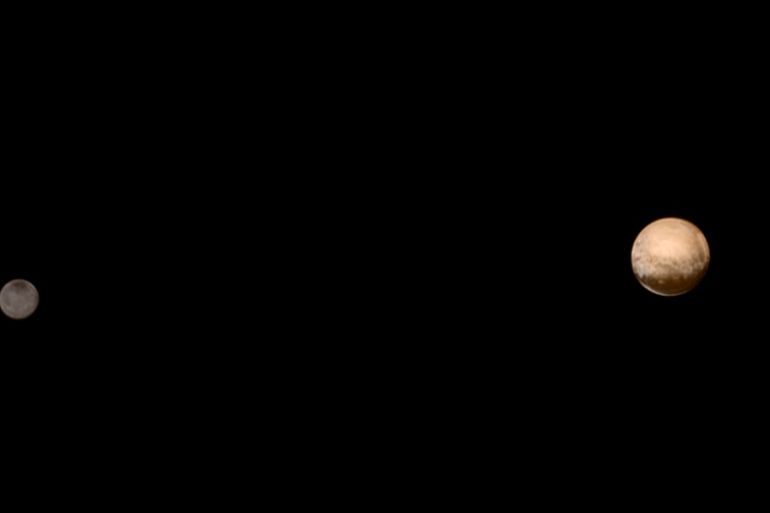NASA spacecraft closes in on Pluto at 14km per second
New Horizons spacecraft poised to become the first probe to visit distant Pluto, capping 50-year reconnaissance mission.

NASA’s New Horizons spacecraft is poised to become the first probe to visit distant Pluto, capping a reconnaissance of the solar system that began more than 50 years ago.
“[The spacecraft] is very healthy, it has just happily taken away all the commands necessary to carry out the observations,” Mark Holdridge, Pluto Mission Encounter Manager said on Friday.
Keep reading
list of 4 itemsCould shipping containers be the answer to Ghana’s housing crisis?
Are Chinese electric vehicles taking over the world?
First pig kidney in a human: Is this the future of transplants?
The newest black and white image from New Horizons’ Long Range Reconnaissance Imager (LORRI) appeared on Friday, showing Pluto as never before, NASA said in a statement.
![An annotated version indicates features described in the text, including a reference globe showing Pluto’s orientation in the image, with the equator and central meridian in bold [NASA]](/wp-content/uploads/2015/07/7480f25715de4b52839b91d161bdda36_18.jpeg)
The five billion-km journey to Pluto, an unexpectedly peach-hued world with contrasting dark and light regions across its face, has taken more than nine years.
For most of the voyage – the equivalent of flying 120,477 times around Earth – the probe hibernated, saving wear-and-tear on its systems and trimming ground control costs to help the mission meet its $720m budget.
![An artist impression of the New Horizons spacecraft that is expected to come as close as 12,500km from Pluto at 11:49 GMT on Tuesday [NASA]](/wp-content/uploads/2015/07/7803196001b54925abf7094480794c9c_18.jpeg)
Clipping along 14km per second, New Horizons awoke in January to begin observations of Pluto and its primary moon, Charon, located beyond Neptune in the Kuiper Belt region, which was discovered in 1992.
Downgraded
Before then, Pluto was considered an odd, outlier ninth planet of the solar system, smaller than Earth’s moon and out of place among the gas giants that occupy what was previously considered the outer solar system.
Six months after New Horizons launched and with more than 40 Kuiper Belt objects on the books, the International Astronomical Union made a controversial call to reclassify Pluto as a “dwarf planet”.
A Kuiper Belt is regarded as a region of the Solar System that exists beyond the eight planets.
Astronomers have since discovered about 2,000 more Kuiper Belt residents out of a population estimated at hundreds of thousands.
Ironically, it was the discovery of the Kuiper Belt that provided the scientific motivation and money for a mission to Pluto. Scientists believe the Kuiper Belt holds fossils from the formation of the solar system 4.6 billion years ago.
New Horizons will conduct its science on the fly, much like NASA’s Pioneer, Mariner and Voyager missions of the 1960s to the 1980s, when exploration of the solar system began.
Built lean, New Horizons does not carry propellant for a braking burn to slow down and slip into orbit around Pluto.
A computer program to orchestra every aspect of the spacecraft’s pass by Pluto began on Tuesday, after a nail-biting computer crash that suspended science operations for three days.
Timing is crucial. New Horizons will have just 30 minutes to conduct the most important part of the mission, including photographing Pluto and Charon, determining what the icy worlds are made of and scanning Pluto’s atmosphere – all done while the probe and Pluto finally cross paths.
“So far it is looking really good, looks like we are converging and we are happy with this results. We have a couple of opportunities to uplink those updated timing information as well as the most precise estimate that we have for Pluto’s orbit and it’s satellites to the spacecraft right before the closest approach,” said Holdridge.
New Horizons is expected to come as close as 12,500 km from Pluto at 11:49 GMT on Tuesday.
![Ball Aerospace's Ralph camera is fitted on the New Horizons spacecraft to capture the best photos of Pluto [Ball Aerospace & Technologies/AP]](/wp-content/uploads/2015/07/c1113f6b5d3748ca80a9f1b18f7aa70d_18.jpeg)